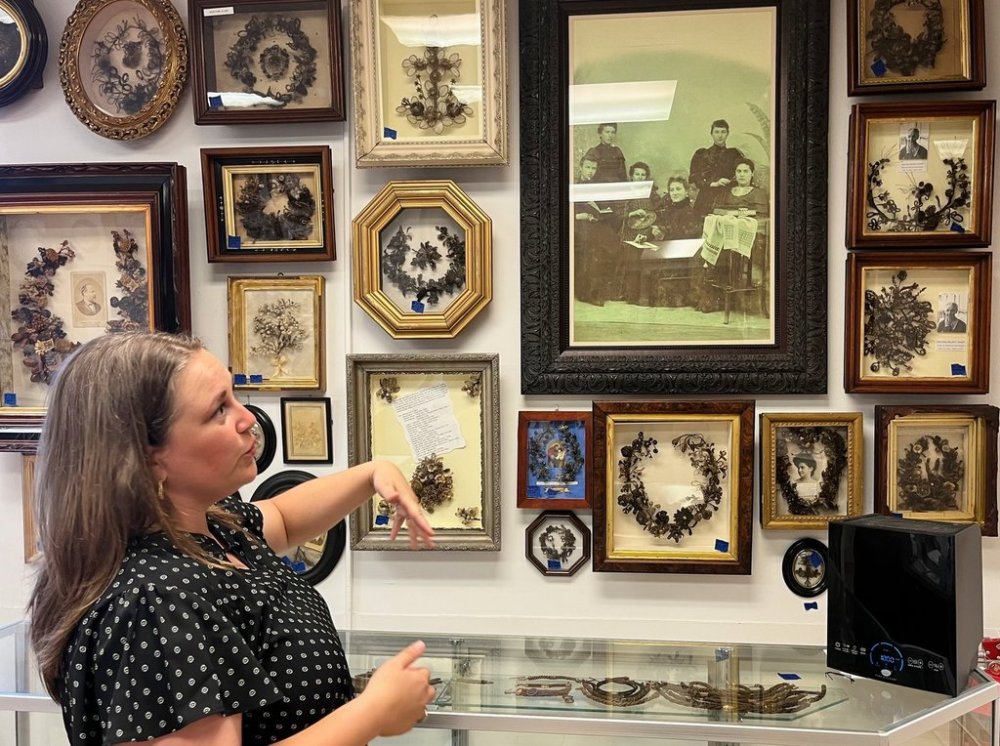World
Hair Museum Closes, Collection Rehomed to Preserve Legacy

The closure of Leila’s Hair Museum in Independence, Missouri, marks the end of a unique chapter in art and history. The museum, renowned for its extensive collection of hair art, will see its more than 3,000 pieces rehomed to various institutions, including the prestigious Metropolitan Museum of Art in New York and the National Museum of Women in the Arts in Washington, D.C. This decision follows the passing of its founder, Leila Cohoon, who died in November 2022 at the age of 92.
For nearly three decades, the museum attracted visitors captivated by its historical artifacts, which included century-old wreaths crafted from human hair. The collection also featured necklaces and watch bands made from hair, alongside locks purported to belong to notable figures such as past U.S. presidents, Marilyn Monroe, and even Jesus.
Leila Cohoon’s granddaughter, Lindsay Evans, is now tasked with the delicate process of rehoming the collection. “Every time I come here, I feel her here,” Evans remarked during a recent tour with representatives from the National Museum of Funeral History in Houston, who selected around 30 artifacts. “This place is her. And so I feel like this process of rehoming her collection has helped me grieve her in a way that I didn’t even realize I really needed.”
The genesis of this extraordinary collection dates back to 1956, when Cohoon, then a hairdresser, discovered a gold frame filled with strands of hair fashioned into flowers while shopping for Easter shoes. “She said forget the Easter shoes,” Evans recalled. “My granddad always said that this was the most expensive piece of the museum because look at what it started.” Evans plans to keep this initial piece for herself.
Hair art flourished in the mid-1800s, with women creating intricate jewelry and memorial pieces from the hair of deceased loved ones. However, by the 1940s, this form of artistic expression had largely fallen out of favor, as photographs became the preferred method of preserving memories. Evans noted that hair art has often been overlooked, primarily because it was predominantly created by women.
Leila Cohoon dedicated her life to preserving this art form, saving countless pieces from being discarded, authoring a book, and teaching classes to inspire a new generation of artists. She often negotiated with antique dealers not just for the frames but insisted they keep the hair intact. “If it had hair, she got it,” Evans said, reflecting on her grandmother’s relentless pursuit of new additions to the collection.
Among the highlights of the collection is a wreath containing hair from every woman in the League of Women Voters from Vermont in 1865, and two crescent-shaped wreaths made from the hair of sisters who had their heads shaved upon entering a convent. Some pieces even incorporate taxidermy, showcasing the diversity of hair art.
As word spread about this unusual museum, it attracted celebrities, including actress and comedian Phyllis Diller, who donated a family heirloom hair wreath. Television personality Mike Rowe featured the museum on his show, “Somebody’s Gotta Do It.” There are also anecdotes of Ozzy Osbourne visiting, during which Cohoon snipped a lock of his hair, although Evans has yet to locate that particular piece.
While the exact value of the entire collection remains uncertain, Evans estimates it could exceed $1 million. Genevieve Keeney, head of the National Museum of Funeral History, expressed her excitement while examining the collection, particularly the jewelry that commemorated the deceased, including a small pin containing hair from a 7-year-old girl who died in 1811. “I always felt it was important to educate people about death,” Keeney, who is also a licensed mortician, stated. “Our society does such an injustice on getting people to understand what the true emotions are going to feel like when death happens.”
As Evans navigates the bittersweet process of rehoming her grandmother’s legacy, she remains committed to sharing the collection with the public. “I want people to see all of this because that’s what she wanted,” Evans said. “But when this is empty it’ll break my heart a little bit.” This transition signifies not only the end of a unique museum but also the continuation of a legacy that intertwines art and memory in a profoundly human way.
-

 Science2 months ago
Science2 months agoToyoake City Proposes Daily Two-Hour Smartphone Use Limit
-

 Health2 months ago
Health2 months agoB.C. Review Reveals Urgent Need for Rare-Disease Drug Reforms
-

 Top Stories2 months ago
Top Stories2 months agoPedestrian Fatally Injured in Esquimalt Collision on August 14
-

 Technology2 months ago
Technology2 months agoDark Adventure Game “Bye Sweet Carole” Set for October Release
-

 World2 months ago
World2 months agoJimmy Lai’s Defense Challenges Charges Under National Security Law
-

 Technology2 months ago
Technology2 months agoKonami Revives Iconic Metal Gear Solid Delta Ahead of Release
-

 Technology2 months ago
Technology2 months agoSnapmaker U1 Color 3D Printer Redefines Speed and Sustainability
-

 Technology2 months ago
Technology2 months agoAION Folding Knife: Redefining EDC Design with Premium Materials
-

 Technology2 months ago
Technology2 months agoSolve Today’s Wordle Challenge: Hints and Answer for August 19
-

 Business2 months ago
Business2 months agoGordon Murray Automotive Unveils S1 LM and Le Mans GTR at Monterey
-

 Lifestyle2 months ago
Lifestyle2 months agoVictoria’s Pop-Up Shop Shines Light on B.C.’s Wolf Cull
-

 Technology2 months ago
Technology2 months agoApple Expands Self-Service Repair Program to Canada









